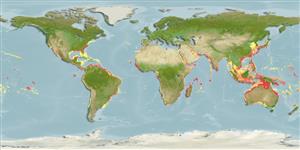>
Tetraodontiformes (Puffers and filefishes) >
Monacanthidae (Filefishes)
Etymology: Aluterus: Name from Greek meaning not free or detached, referring to the pelvis that does not form a spiny project (as it does in triggerfish) (R. Chandler, pers. Comm. 10/2014).
More on author: Linnaeus.
Environment: milieu / climate zone / rango de profundidad / distribution range
Ecología
marino asociado a arrecife; rango de profundidad 1 - 80 m (Ref. 90102). Subtropical; 43°N - 39°S, 180°W - 180°E
Circumtropical. Western Atlantic: Massachusetts, USA to Argentina (Ref. 36453). Eastern Atlantic: west coast of tropical Africa (Ref. 3592). Eastern Pacific: Guatemala to Chile (Ref. 9068); probably in Mexico (Ref. 9318). Western Indian Ocean: Mozambique and South Africa (Ref. 4421). Recorded from La Reunion (Ref. 53568).
Tamaño / Peso / Age
Madurez: Lm ? range ? - ? cm
Max length : 76.2 cm TL macho / no sexado; (Ref. 26340); common length : 40.0 cm TL macho / no sexado; (Ref. 3467); peso máximo publicado: 2.7 kg (Ref. 40637)
Espinas dorsales (total) : 2; Radios blandos dorsales (total) : 45 - 52; Espinas anales: 0; Radios blandos anales: 47 - 53. Rudimentary pelvic spine disappears in large specimen (Ref. 36453). Snout convex in adults (Ref. 1602). Sandy to grey with small brown spots above; soft dorsal and anal fins pale yellowish to brownish; caudal membrane blackish brown (Ref. 4421).
Body shape (shape guide): short and / or deep.
Occasionally in shallow water by steep drop-offs. Solitary or in pairs, occasionally in groups of five or six, at less than 10 m depth. Juveniles are pelagic, seen under floating objects (Ref. 9318, 48637). Benthopelagic (Ref. 58302). Adults and juveniles are rarely seen near reefs. Juveniles often with large jellies and these may bring them close to reefs and adults may nest on sandflats adjacent to reefs in deep water. At other times, the adults may form large schools under weed-rafts that usually form during the wet season (Ref. 48637). Feed on benthic organisms (Ref. 30573).
Life cycle and mating behavior
Madurez | Reproducción | Puesta | Huevos | Fecundidad | Larva
Distinct pairing (Ref. 205).
Harmelin-Vivien, M.L. and J.-C. Quéro, 1990. Monacanthidae. p. 1061-1066. In J.C. Quero, J.C. Hureau, C. Karrer, A. Post and L. Saldanha (eds.) Check-list of the fishes of the eastern tropical Atlantic (CLOFETA). JNICT, Lisbon; SEI, Paris; and UNESCO, Paris. Vol. 2. (Ref. 3592)
IUCN Red List Status (Ref. 130435: Version 2025-1)
Threat to humans
Reports of ciguatera poisoning (Ref. 30911)
Human uses
Pesquerías: comercial; pesca deportiva: si
Herramientas
Special reports
Download XML
Fuentes de Internet
Estimates based on models
Preferred temperature (Referencia
123201): 22.8 - 29, mean 27.6 °C (based on 1868 cells).
Phylogenetic diversity index (Referencia
82804): PD
50 = 0.5625 [Uniqueness, from 0.5 = low to 2.0 = high].
Bayesian length-weight: a=0.01905 (0.01192 - 0.03047), b=2.89 (2.75 - 3.03), in cm total length, based on LWR estimates for this species & (Sub)family-body (Ref.
93245).
Nivel trófico (Referencia
69278): 3.8 ±0.0 se; based on diet studies.
Generation time: 5.0 ( na - na) years. Estimated as median ln(3)/K based on 1
growth studies.
Resiliencia (Referencia
120179): Medio, población duplicada en un tiempo mínimo de 1.4-4.4 años (Preliminary K or Fecundity.).
Fishing Vulnerability (Ref.
59153): Moderate to high vulnerability (48 of 100).
🛈
Nutrients (Ref.
124155): Calcium = 13.9 [5.6, 53.9] mg/100g; Iron = 0.487 [0.214, 1.238] mg/100g; Protein = 19.3 [17.1, 21.4] %; Omega3 = 0.154 [0.071, 0.304] g/100g; Selenium = 21.9 [8.3, 50.9] μg/100g; VitaminA = 23.4 [6.0, 98.0] μg/100g; Zinc = 0.522 [0.321, 0.882] mg/100g (wet weight);
